Evaluation of Site Suitability for Photovoltaic Power Plants in the Beijing–Tianjin–Hebei Region of China Using a Combined Weighting Method
Abstract
:1. Introduction
2. Materials and Methods
2.1. Study Region
2.2. Data Source and Preprocessing
2.3. Subjective and Objective Comprehensive Suitability Evaluation Method for Photovoltaic Power Plants
2.3.1. Principle of AHP
2.3.2. The Principle of the XGBoost Distributed Gradient-Boosting Library
2.3.3. Principle of Combination Weight Calculation
2.3.4. Principle of Evaluation of the Suitability of Solar Power Plants through Geographic Spatial Analysis
2.4. The Detemination of Weight for Evaluation Indicators
2.4.1. The Weighted Evaluation of Metrics Based on AHP
- Criterion level discrimination matrix:
- 2.
- Indicator level discrimination matrix:
- 3.
- Indicator level discrimination matrix:
2.4.2. The Weighted Evaluation of Metrics Based on XGBoost
2.4.3. Evaluation of the Suitability of Solar Power Plants through Geographic Spatial Analysis
3. Results and Analysis
3.1. Standardized Processed Data of Suitability Evaluation Factors
3.2. Standardized Processed Data of Land Cover
3.3. Evaluation of Photovoltaic Electric Field Location
3.3.1. Overall Evaluation of the Beijing–Tianjin–Hebei Region
3.3.2. The Assessment of Key Areas for the Suitability of Photovoltaic Power Plants in the Beijing–Tianjin–Hebei Region
4. Discussion and Conclusions
- (1)
- In the Beijing–Tianjin–Hebei region, approximately 4.88 × 104 km2 of the total area is suitable, accounting for 21.59% of the total area. Divided by the “Yanshan-Taihang Mountains” range, the majority of suitable areas are located in Baoding, Chengde, and Zhangjiakou cities on the northwest of the mountains, while there is a lower distribution of suitable areas in Beijing and Tianjin on the southeast side. Therefore, the government in the formulation of photovoltaic power plant policy or investors in site selection investment, can give priority to Baoding Chengde and Zhangjiakou and other cities.
- (2)
- The suitable areas primarily consist of generally suitable areas, with a predominant presence of mountainous terrain. The complex terrain in mountainous areas puts forward higher technical requirements and costs for project implementation. In addition, the long-term impact of photovoltaic power plant development on the local ecological environment is not clear, so the photovoltaic power plant should be continuously monitored for soil and water conservation and ecological restoration.
- (3)
- The selection of evaluation of indicators in this study fully considers their applicability in the study area, and the quantification of index weights based on the combination method enhances the scientific and targeted nature of the final evaluation results. However, due to regional constraints and data sources, there is a lack of comprehensive consideration for ecological and climatic elements’ impact on suitability. For instance, local rainfall can reduce photovoltaic panel power generation efficiency, a mountain slope aspect can limit photovoltaic panel installation, and a poor geological structure can affect engineering construction economics. The primary objective of photovoltaic is to decrease reliance on fossil fuels while providing greater economic and social benefits to users and investors. Therefore, future research should prioritize the incorporation of additional micro influencing factors into the evaluation indicators to enhance the comprehensiveness of the evaluation system.
Author Contributions
Funding
Data Availability Statement
Conflicts of Interest
References
- Lee, H.; Calvin, K.; Dasgupta, D.; Krinner, G.; Mukherji, A.; Thorne, P.; Trisos, C.; Romero, J.; Aldunce, P.; Ruane, A.C. CLIMATE CHANGE 2023 Synthesis Report Summary for Policymakers; Intergovernmental Panel on Climate Change: Geneva, Switzerland, 2024. [Google Scholar]
- Allen, M.; Dube, O.P.; Solecki, W.; Aragón-Durand, F.; Cramer, W.; Humphreys, S.; Kainuma, M. Special Report: Global Warming of 1.5 C; Intergovernmental Panel on Climate Change (IPCC): Geneva, Switzerland, 2018. [Google Scholar]
- Crippa, M.; Guizzardi, D.; Banja, M.; Solazzo, E.; Muntean, M.; Schaaf, E.; Pagani, F.; Monforti-Ferrario, F.; Olivier, J.G.J.; Quadrelli, R. CO2 Emissions of All World Countries; JRC Science for Policy Report; European Commission, EUR: Brussels, Belgium, 2022; p. 31182.
- May, B. World Economic Prospects Monthly. Econ. Outlook 2018, 42, 1–33. [Google Scholar]
- Zou, C.; Chen, Y.; Xiong, B.; Liu, H. Mission of new energy under carbon neutrality goal in China. Bull. Chin. Acad. Sci. 2023, 38, 48–58. [Google Scholar] [CrossRef]
- Xu, Y. Research on Power Transition Theory and Planning Method under Interactive Institution-Policy-Technology Regime. Ph.D. Thesis, North China Electric Power University, Beijing, China, 2016. [Google Scholar]
- Zhang, C. China’s “Dual Carbon” Goals and Practices: Forming Logic, Realistic Challenges, Social Risks and Advancing Route. J. Hohai Univ. (Philos. Soc. Sci.) 2022, 24, 78–87+131. [Google Scholar]
- Purohit, P. CO2 Emissions Mitigation Potential of Solar Home Systems under Clean Development Mechanism in India. Energy 2009, 34, 1014–1023. [Google Scholar] [CrossRef]
- He, Y.; Che, Y.; Lyu, Y.; Lu, Y.; Zhang, Y. Social Benefit Evaluation of China’s Photovoltaic Poverty Alleviation Project. Renew. Energy 2022, 187, 1065–1081. [Google Scholar] [CrossRef]
- Liu, Y. Feasibility Evaluation of the Photovoltaic Power Generation ’s Construction from the Perspective of Targeted Poverty Alleviation. J. Beijing Inst. Technol. (Soc. Sci. Ed.) 2017, 19, 37–43. [Google Scholar]
- Na, R. Researching on Location of Wind Power Farm Based on Fuzzy Comprehensive Evaluation Model. Master’s Thesis, North China Electric Power University, Beijing, China, 2015. [Google Scholar]
- Sun, Y.; Zhu, D.; Li, Y.; Wang, R.; Ma, R. Spatial Modelling the Location Choice of Large-Scale Solar Photovoltaic Power Plants: Application of Interpretable Machine Learning Techniques and the National Inventory. Energy Convers. Manag. 2023, 289, 117198. [Google Scholar] [CrossRef]
- Noorollahi, Y.; Senani, A.G.; Fadaei, A.; Simaee, M.; Moltames, R. A Framework for GIS-Based Site Selection and Technical Potential Evaluation of PV Solar Farm Using Fuzzy-Boolean Logic and AHP Multi-Criteria Decision-Making Approach. Renew. Energy 2022, 186, 89–104. [Google Scholar] [CrossRef]
- Šúri, M.; Hofierka, J. A New GIS-Based Solar Radiation Model and Its Application to Photovoltaic Assessments. Trans. GIS 2004, 8, 175–190. [Google Scholar] [CrossRef]
- Doorga, J.R.S.; Hall, J.W.; Eyre, N. Geospatial Multi-Criteria Analysis for Identifying Optimum Wind and Solar Sites in Africa: Towards Effective Power Sector Decarbonization. Renew. Sustain. Energy Rev. 2022, 158, 112107. [Google Scholar] [CrossRef]
- Wang, C.-N.; Nguyen, V.T.; Thai, H.T.N.; Duong, D.H. Multi-Criteria Decision Making (MCDM) Approaches for Solar Power Plant Location Selection in Viet Nam. Energies 2018, 11, 1504. [Google Scholar] [CrossRef]
- Perpiña Castillo, C.; Batista e Silva, F.; Lavalle, C. An Assessment of the Regional Potential for Solar Power Generation in EU-28. Energy Policy 2016, 88, 86–99. [Google Scholar] [CrossRef]
- Ali, S.; Taweekun, J.; Techato, K.; Waewsak, J.; Gyawali, S. GIS Based Site Suitability Assessment for Wind and Solar Farms in Songkhla, Thailand. Renew. Energy 2019, 132, 1360–1372. [Google Scholar] [CrossRef]
- Hasti, F.; Mamkhezri, J.; McFerrin, R.; Pezhooli, N. Optimal Solar Photovoltaic Site Selection Using Geographic Information System–Based Modeling Techniques and Assessing Environmental and Economic Impacts: The Case of Kurdistan. Sol. Energy 2023, 262, 111807. [Google Scholar] [CrossRef]
- Haddad, B.; Díaz-Cuevas, P.; Ferreira, P.; Djebli, A.; Pérez, J.P. Mapping Concentrated Solar Power Site Suitability in Algeria. Renew. Energy 2021, 168, 838–853. [Google Scholar] [CrossRef]
- Min, Z.; Hu, Y.; Liu, Y.; Wang, Z.; Chen, Z.; Li, H.; Jia, X. Suitability of Forest Grass PV Complementary Space and Carbon Fixation and Reduction Benefits in Yan’an. J. Northwest For. Univ. 2023, 38, 57–66. [Google Scholar]
- Ding, Y.A. Preliminary Study on the Construction of Artificial Grassland under Photovoltaic Frame. Master’s Thesis, Inner Mongolia Agricultural University, Hohhot, China, 2018. [Google Scholar]
- An, W. Research on Mechanism and Model of Photovoltaic Industry Poverty Alleviation in China. Master’s Thesis, Shanxi University of Finance & Economics, Taiyuan, China, 2019. [Google Scholar]
- Yang, K.; Fan, B. The Innovative Geographical Foundation of the Relative Decline of Economic Growth in Beijing-Tianjin-Hebei Region. Acta Geogr. Sin. 2022, 77, 1320–1338. [Google Scholar]
- Zhao, L.; Zhang, G. Evaluation and Welfare Effect of Coordinated Ecological Development of the Beijing–Tianjin–Hebei Region. Chin. J. Popul. Resour. Environ. 2021, 19, 283–290. [Google Scholar] [CrossRef]
- Zhang, J.; Zheng, Y. The Flexibility Pathways for Integrating Renewable Energy into China’s Coal Dominated Power System: The Case of Beijing-Tianjin-Hebei Region. J. Clean. Prod. 2020, 245, 118925. [Google Scholar] [CrossRef]
- Han, H.; Guo, L.; Zhang, J.; Zhang, K.; Cui, N. Spatiotemporal Analysis of the Coordination of Economic Development, Resource Utilization, and Environmental Quality in the Beijing-Tianjin-Hebei Urban Agglomeration. Ecol. Indic. 2021, 127, 107724. [Google Scholar] [CrossRef]
- Liu, C.; Deng, X.; Zhu, B.; Yin, C. Characteristics of GSR of China’s Three Major Economic Regions in the Past 10 Years and Its Relationship with O3 and PM2.5. China Environ. Sci. 2018, 38, 2820–2829. [Google Scholar]
- Liu, L.; Sun, Z.; Wu, F.; Zhang, X.; Zhang, Q. Evaluation of Suitability and Emission Reduction Benefits of Photovoltaic Development in Beijing-Tianjin-Hebei Region. Acta Geogr. Sin. 2022, 77, 665–678. [Google Scholar]
- Zhao, S.; Yu, L.; Zhang, Z. Photovoltaic Supply Chain and Government Subsidy Decision-Making Based on China’s Industrial Distributed Photovoltaic Policy: A Power Perspective. J. Clean. Prod. 2023, 413, 137438. [Google Scholar] [CrossRef]
- Xiong, Y.; Yang, X. Government Subsidies for the Chinese Photovoltaic Industry. Energy Policy 2016, 99, 111–119. [Google Scholar] [CrossRef]
- Lin, B.; Luan, R. Do Government Subsidies Promote Efficiency in Technological Innovation of China’s Photovoltaic Enterprises? J. Clean. Prod. 2020, 254, 120108. [Google Scholar] [CrossRef]
- Corwin, S.; Johnson, T.L. The Role of Local Governments in the Development of China’s Solar Photovoltaic Industry. Energy Policy 2019, 130, 283–293. [Google Scholar] [CrossRef]
- Nation Bureau of Statistics. Statistical Bulletin on the National Economy and Social Development of the People’s Republic of China in 2021; Nation Bureau of Statistics: Beijing, China, 2022.
- Editorial Committee of China Electric Power Yearbook. China Electric Power Yearbook 2020; China Electric Power Press: Beijing, China, 2022. [Google Scholar]
- Dang, R.; Li, X.; Li, C.; Xu, C. A MCDM Framework for Site Selection of Island Photovoltaic Charging Station Based on New Criteria Identification and a Hybrid Fuzzy Approach. Sustain. Cities Soc. 2021, 74, 103230. [Google Scholar] [CrossRef]
- Li, Y.; Yu, X.; Wang, Z. Risk Assessment on Photovoltaic Power Generation Project by Grey Correlation Analysis and TOPSIS Method. Power Syst. Technol. 2013, 37, 1514–1519. [Google Scholar]
- Liao, H.; Qin, R.; Wu, D.; Yazdani, M.; Zavadskas, E.K. Pythagorean Fuzzy Combined Compromise Solution Method Integrating the Cumulative Prospect Theory and Combined Weights for Cold Chain Logistics Distribution Center Selection. Int. J. Intell. Syst. 2020, 35, 2009–2031. [Google Scholar] [CrossRef]
- Ren, C.; Yue, W.; Liang, X.; Liang, Y.; Liang, J.; Lin, X. Risk assessment of wildfire disaster in Guilin based on XGBoost and combination weight method. J. Saf. Environ. 2023, 23, 1–9. [Google Scholar] [CrossRef]
- Zhang, J.; Huang, D.; You, Q.; Kang, J.; Shi, M.; Lang, X. Evaluation of Emergency Evacuation Capacity of Urban Metro Stations Based on Combined Weights and TOPSIS-GRA Method in Intuitive Fuzzy Environment. Int. J. Disaster Risk Reduct. 2023, 95, 103864. [Google Scholar] [CrossRef]
- Elboshy, B.; Alwetaishi, M.; Aly, R.M.H.; Zalhaf, A.S. A Suitability Mapping for the PV Solar Farms in Egypt Based on GIS-AHP to Optimize Multi-Criteria Feasibility. Ain Shams Eng. J. 2022, 13, 101618. [Google Scholar] [CrossRef]
- Jafari, S.; Aghel, M.; Sohani, A.; Hoseinzadeh, S. Geographical Preference for Installation of Solar Still Water Desalination Technologies in Iran: An Analytical Hierarchy Process (AHP)-Based Answer. Water 2022, 14, 265. [Google Scholar] [CrossRef]
- Salman, M.; Chauhan, R.; Singh, T.; Prabakaran, R.; Kim, S.C. Experimental Investigation and Optimization of Dimple-Roughened Impinging Jet Solar Air Collector Using a Novel AHP-MABAC Approach. Environ. Sci. Pollut. Res. 2022, 30, 36259–36275. [Google Scholar] [CrossRef]
- The Notice on the Issuance of “Hebei Province’s 14th Five-Year Plan for New Energy Storage Development” by the Hebei Provincial Development and Reform Commission. Available online: https://info.hebei.gov.cn/hbszfxxgk/6898876/6898925/6899014/6907489/7019023/index.html (accessed on 26 December 2023).
- The Hebei Province Development and Reform Commission Has Issued A notice on the “New Energy Storage Development Plan” for the 14th Five-Year Plan Period in Hebei Province. Available online: https://gxt.hebei.gov.cn/sme/zc/snzc91/896589/index.html?eqid=a262766000176aec00000003648585fa (accessed on 26 December 2023).
- The Notice on the Organization of Ground Distributed Photovoltaic Project Application by Hebei Province Development and Reform Commission. Available online: http://hbdrc.hebei.gov.cn/nsjg/snyj/xnyc/gzdt_886/202310/t20231024_102142.html (accessed on 26 December 2023).
- Li, F. Analysis of Factors Affecting the Location and Layout of Photovoltaic Power Stations. Econ. Res. Guide 2019, 36, 21–22+34. [Google Scholar]
- Wu, J.; Chen, J. Site Selection Planning of Photovoltaic Power Station:a Case Study of Wuhu City. J. Ludong Univ. (Nat. Sci. Ed.) 2019, 35, 59–65+89. [Google Scholar]
- Heo, J.; Moon, H.; Chang, S.; Han, S.; Lee, D.-E. Case Study of Solar Photovoltaic Power-Plant Site Selection for Infrastructure Planning Using a BIM-GIS-Based Approach. Appl. Sci. 2021, 11, 8785. [Google Scholar] [CrossRef]
- Hashemizadeh, A.; Ju, Y.; Dong, P. A Combined Geographical Information System and Best–Worst Method Approach for Site Selection for Photovoltaic Power Plant Projects. Int. J. Environ. Sci. Technol. 2020, 17, 2027–2042. [Google Scholar] [CrossRef]
- Fang, H.; Li, J.; Song, W. Sustainable Site Selection for Photovoltaic Power Plant: An Integrated Approach Based on Prospect Theory. Energy Convers. Manag. 2018, 174, 755–768. [Google Scholar] [CrossRef]
- Zambrano-Asanza, S.; Quiros-Tortos, J.; Franco, J.F. Optimal Site Selection for Photovoltaic Power Plants Using a GIS-Based Multi-Criteria Decision Making and Spatial Overlay with Electric Load. Renew. Sustain. Energy Rev. 2021, 143, 110853. [Google Scholar] [CrossRef]
- Heo, J.; Song, K.; Han, S.; Lee, D.-E. Multi-Channel Convolutional Neural Network for Integration of Meteorological and Geographical Features in Solar Power Forecasting. Appl. Energy 2021, 295, 117083. [Google Scholar] [CrossRef]
- Wu, Y.; Deng, Z.; Tao, Y.; Wang, L.; Liu, F.; Zhou, J. Site Selection Decision Framework for Photovoltaic Hydrogen Production Project Using BWM-CRITIC-MABAC: A Case Study in Zhangjiakou. J. Clean. Prod. 2021, 324, 129233. [Google Scholar] [CrossRef]
- Cheng, L. The application of analytic hierarchy process (AHP) and geographic information system (GIS) in lightning disaster risk-zoning in Henan province. J. Nanjing Univ. Inf. Sci. Technol. 2019, 11, 234–240. [Google Scholar]
- Ming, J. Research on the Location-Allocation Model for Urban Fire Stations under Fire Risk. Ph.D. Thesis, University of Science and Technology of China, Hefei, China, 2022. [Google Scholar]
- Li, Z.; Liu, Z. Feature selection algorithm based on XGBoost. J. Commun. 2019, 40, 101–108. [Google Scholar]
- Rocha, P.A.C.; Santos, V.O. Global Horizontal and Direct Normal Solar Irradiance Modeling by the Machine Learning Methods XGBoost and Deep Neural Networks with CNN-LSTM Layers: A Case Study Using the GOES-16 Satellite Imagery. Int. J. Energy Environ. Eng. 2022, 13, 1271–1286. [Google Scholar] [CrossRef]
- Li, X.; Ma, L.; Chen, P.; Xu, H.; Xing, Q.; Yan, J.; Lu, S.; Fan, H.; Yang, L.; Cheng, Y. Probabilistic Solar Irradiance Forecasting Based on XGBoost. Energy Rep. 2022, 8, 1087–1095. [Google Scholar] [CrossRef]
- Kim, Y.; Byun, Y. Predicting Solar Power Generation from Direction and Tilt Using Machine Learning XGBoost Regression. J. Phys. Conf. Ser. 2022, 2261, 012003. [Google Scholar] [CrossRef]
- Wang, Q. Prediction and Analysis on the Direction of Stock Rate Return Using Machine Learning. Master’s Thesis, University of Science and Technology of China, Hefei, China, 2019. [Google Scholar]
- Yan, B.; Sun, J.; Wang, X.; Li, X.; Sun, F.; Fu, D. Suitability Zoning of Groundwater Source Heat Pump in Shijiazhuang Based on GIS-FAHP. J. Jilin Univ. (Earth Sci. Ed.) 2021, 51, 1172–1181. [Google Scholar] [CrossRef]
- Huang, Q.; Tan, C.; Yang, B. Research on the Evaluation Method of Ecotourism Suitability in Subtropical Regions based on XGBoost Algorithm. J. Geo-Inf. Sci. 2023, 28, 1–15. [Google Scholar]
- Li, J.; Yuan, W. Assessment of Urban Land Ecological Security in Yinchuan City Based on the Grid Method. J. Nat. Resour. 2017, 32, 988–1001. [Google Scholar]
- Wang, F.; Shi, X.; Zheng, H.; Wu, Y. A Crucial Question and Ten Relationships: Explorations on the Transformation of Beijing City Master Plan (2016–2035). City Plan. Rev. 2017, 41, 9–16+32. [Google Scholar]
- Regulations on Promoting the Development of New Energy in Hebei Province. Available online: http://www.lvsefazhan.cn/index.php/guozijianguan/2400.html (accessed on 31 October 2023).
- Department of Ecology and Environment of Hebei Province. Hebei Province Pollution Reduction and Carbon Reduction Synergy Implementation Plan; Department of Ecology and Environment of Hebei Province: Zhengzhou, China, 2023. [Google Scholar]
- Zhang, Y.; Ren, J.; Pu, Y.; Wang, P. Solar Energy Potential Assessment: A Framework to Integrate Geographic, Technological, and Economic Indices for a Potential Analysis. Renew. Energy 2020, 149, 577–586. [Google Scholar] [CrossRef]
- Zhang, J. Assessment of Renewable Energy Potentials Based on GIS and RS: A Case Study in China. Ph.D. Thesis, Technische Universität, Dortmund, Germany, 2015. [Google Scholar]
- Liu, J.; Shuai, J.; Shuai, C.; Wang, Z.; Huang, F. Impacts of Solar Photovoltaic Projects on Sustainable Livelihoods: Evidence from Rural China. Energy Sustain. Dev. 2023, 74, 314–327. [Google Scholar] [CrossRef]
- Wang, Y.; Cui, X.; Huang, H. Spatial Patterns and Environmental Benefits of Photovoltaic Poverty Alleviation Programs in China. Environ. Impact Assess. Rev. 2023, 103, 107272. [Google Scholar] [CrossRef]
- Wang, J. Large Distributed Photovoltaic Powergeneration Project Comprehensive Evaluation. Master’s Thesis, Beijing University of Chemical Technology, Beijing, China, 2017. [Google Scholar]
- Yang, Q.; Huang, T.; Wang, S.; Li, J.; Dai, S.; Wright, S.; Wang, Y.; Peng, H. A GIS-Based High Spatial Resolution Assessment of Large-Scale PV Generation Potential in China. Appl. Energy 2019, 247, 254–269. [Google Scholar] [CrossRef]

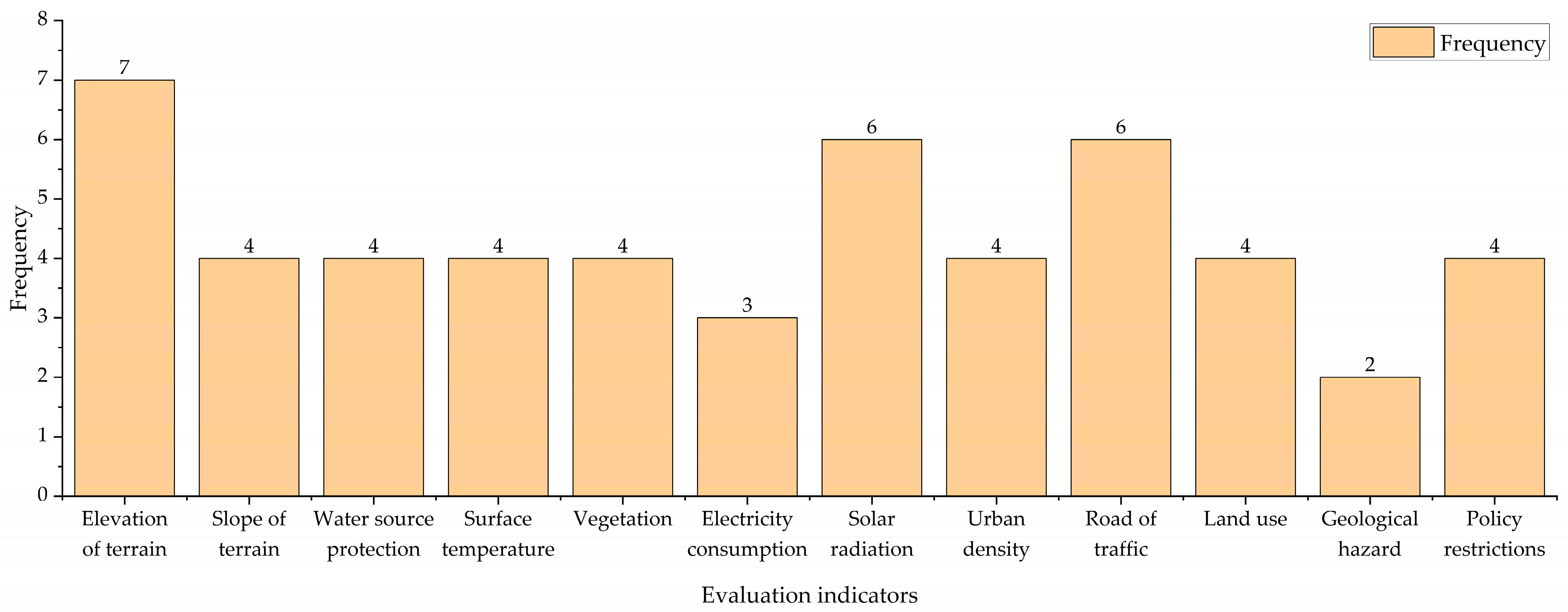




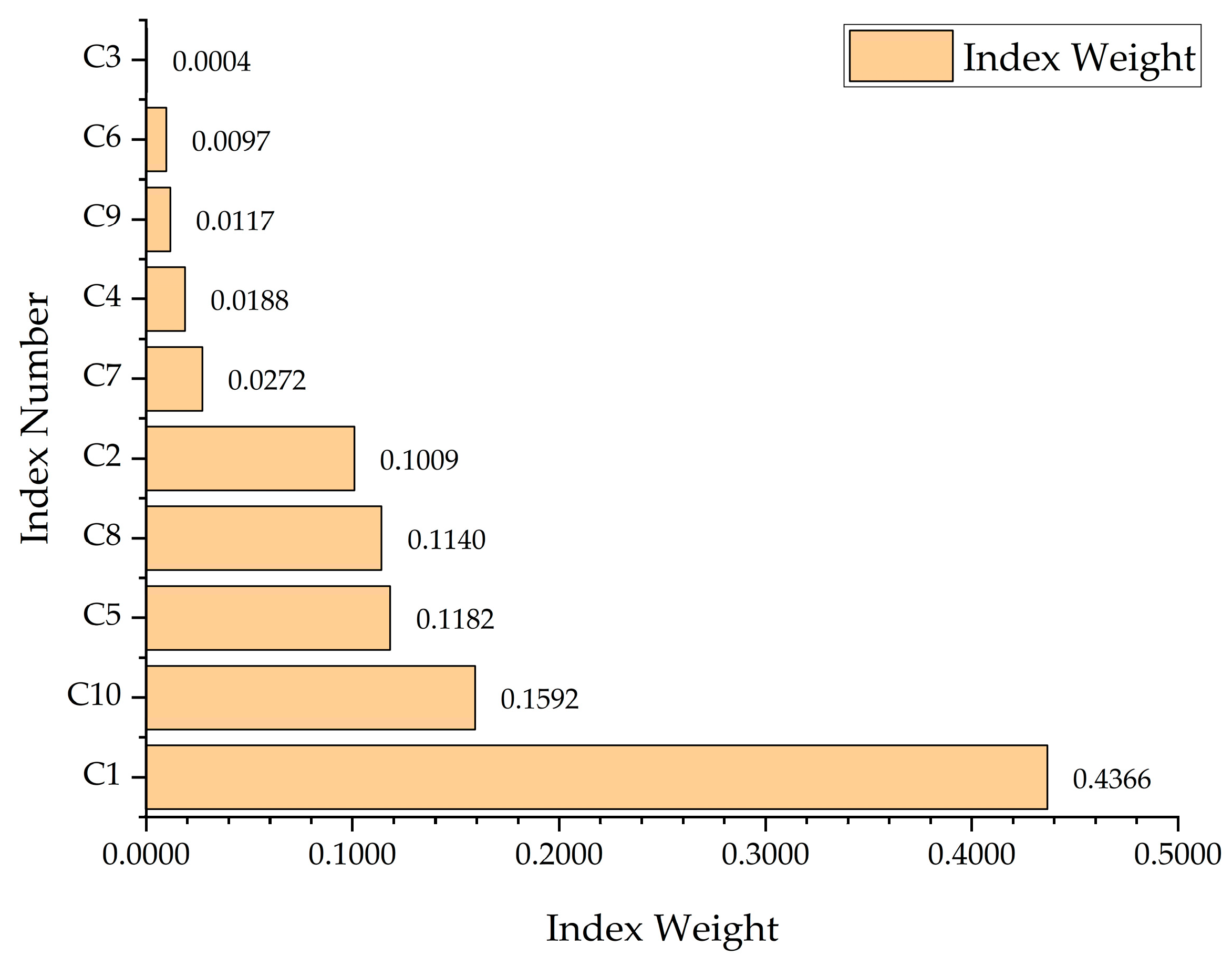

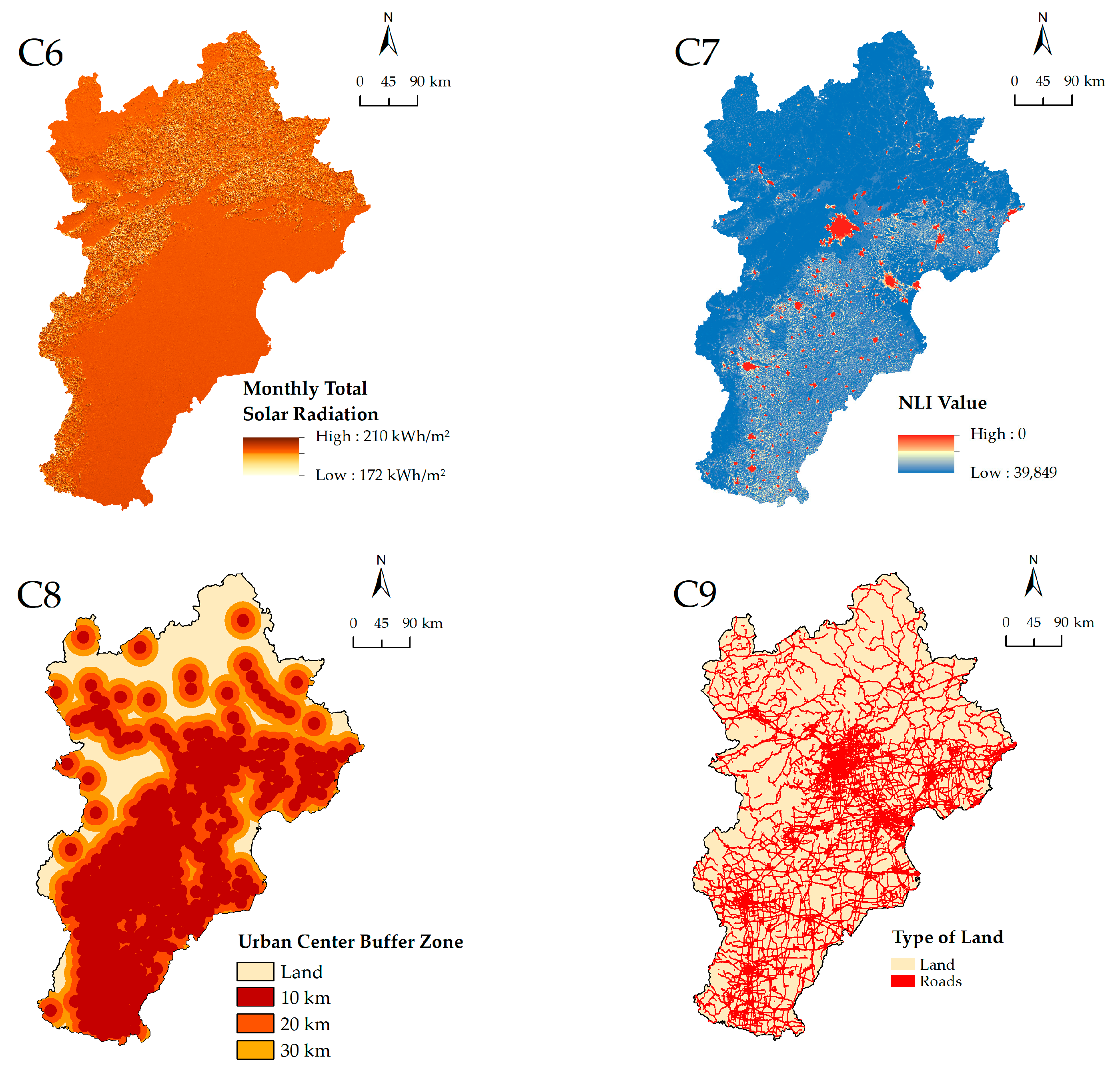
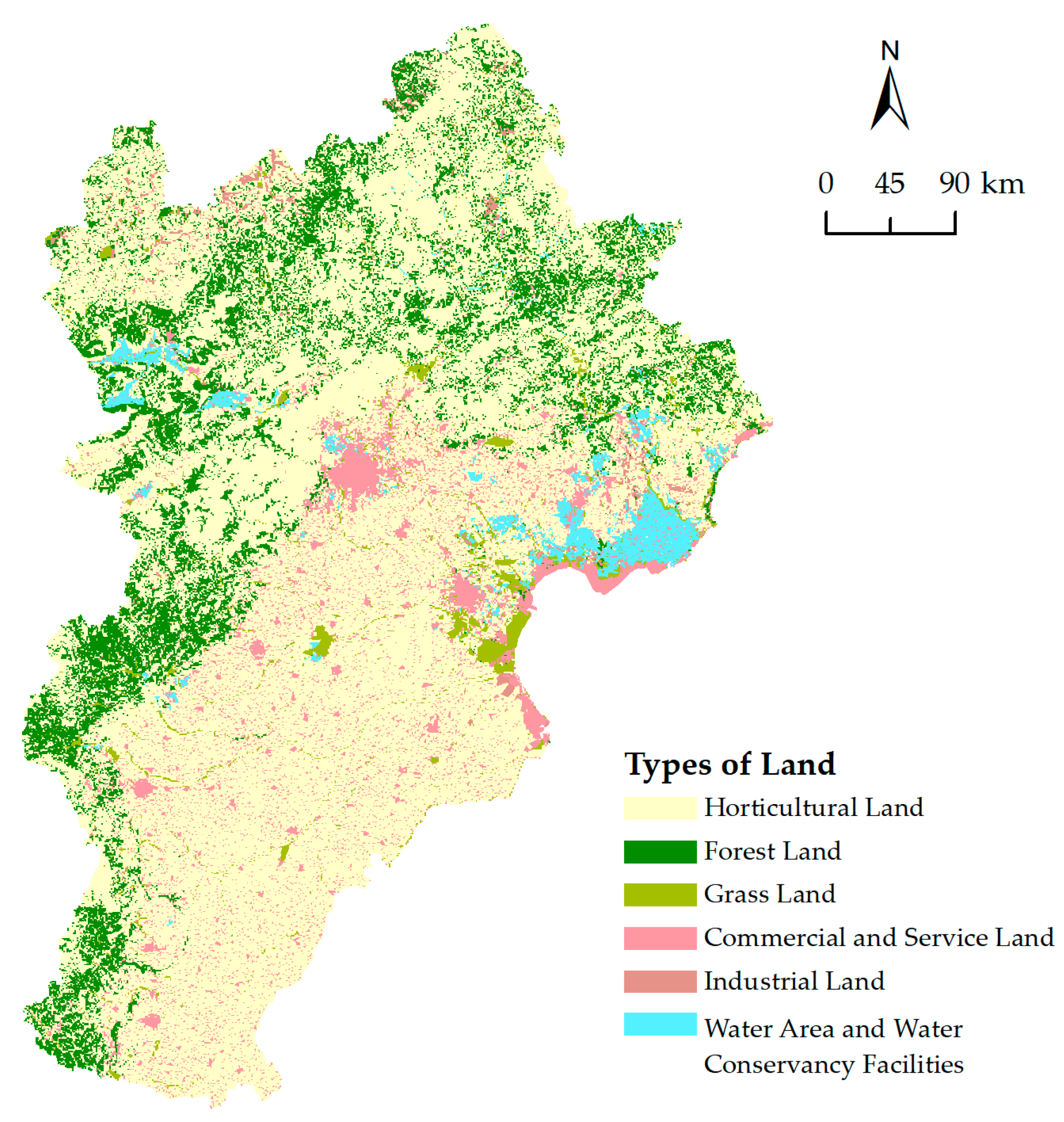

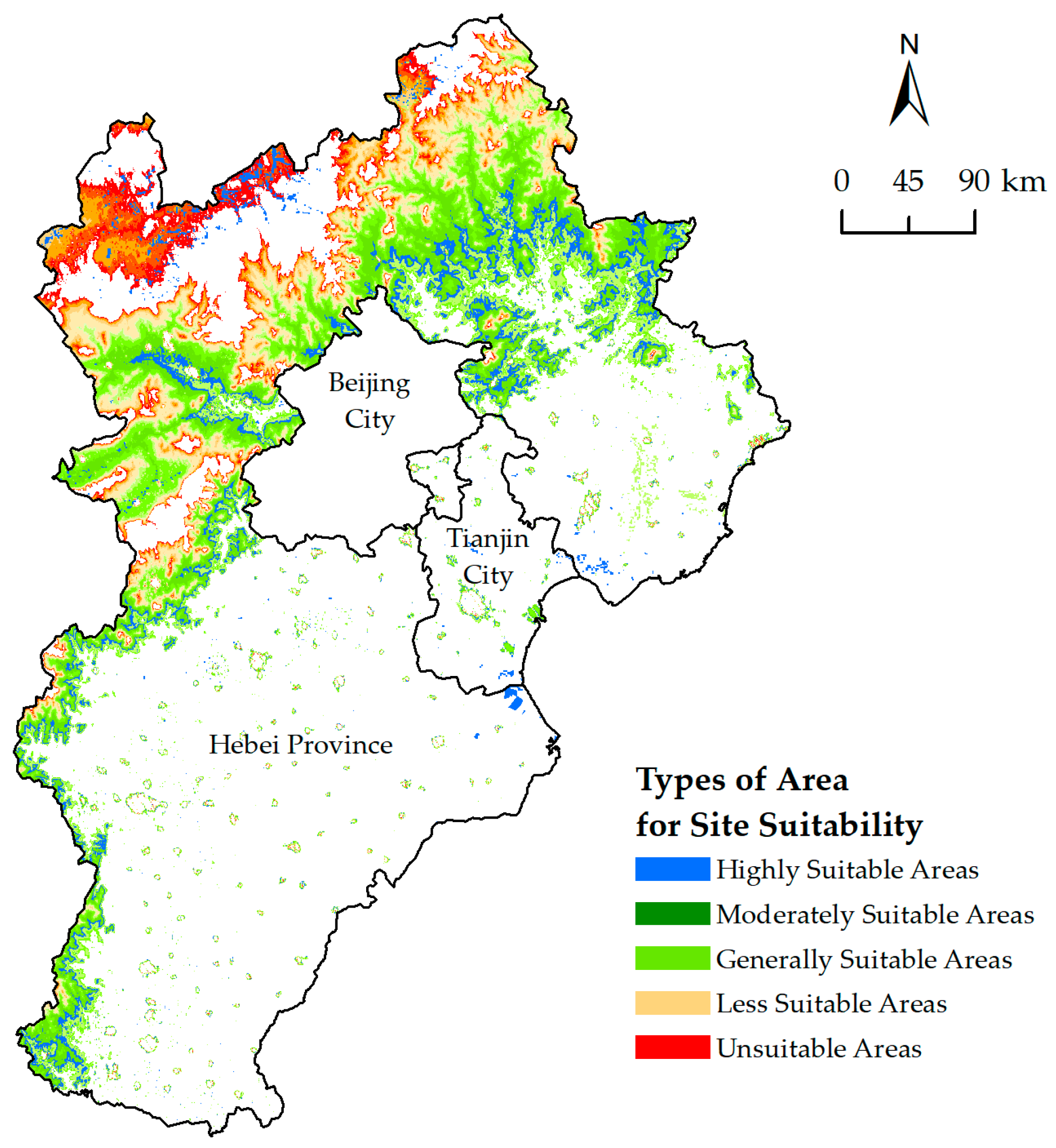
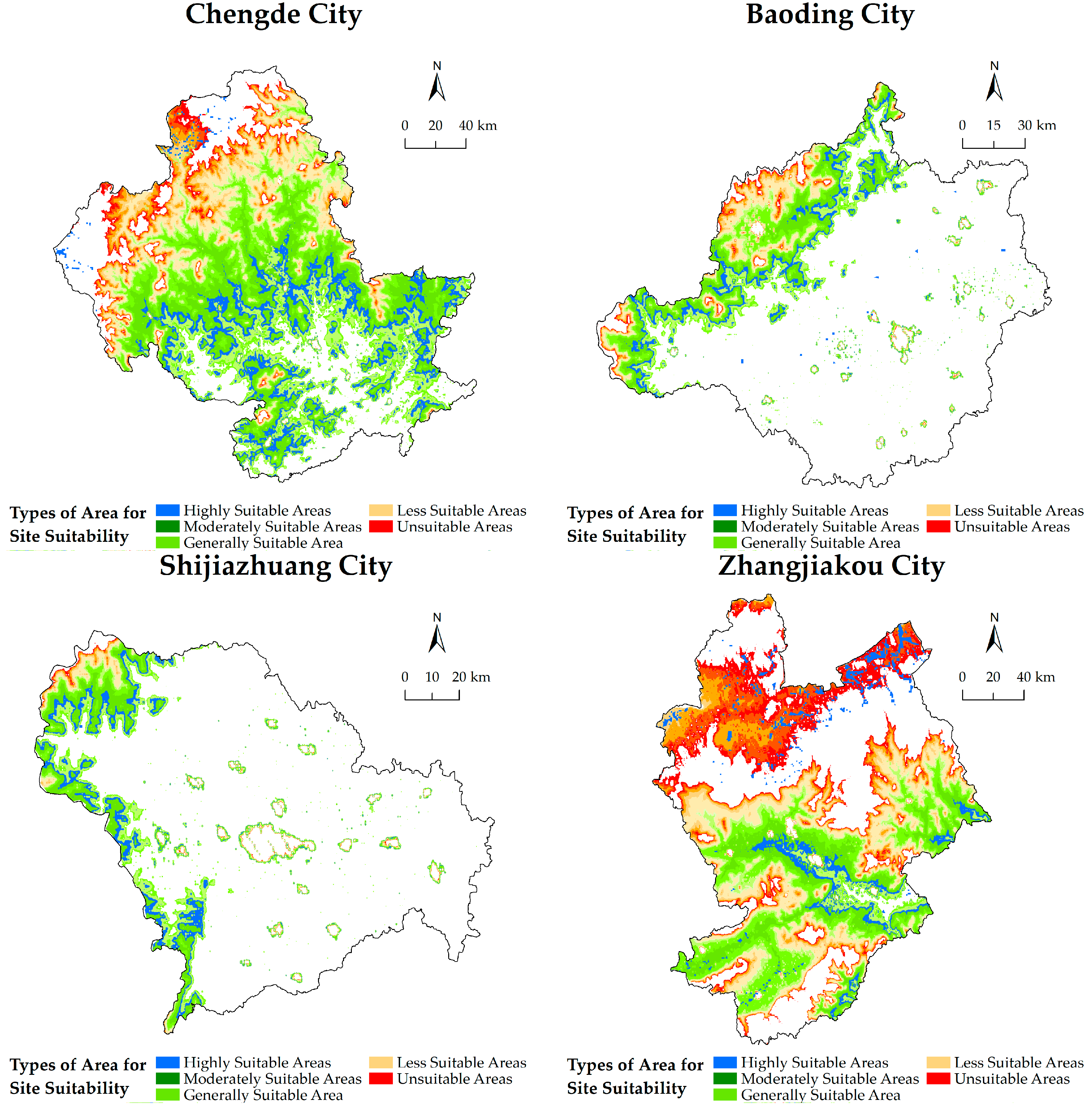


| Data Name | Source |
|---|---|
| Meteorological data | China Meteorological Administration (http://data.cma.cn, accessed on 5 June 2023.) |
| Topographic and geomorphologic data | Geospatial data cloud (http://www.gscloud.cn, accessed on 20 May 2023.) |
| Land use data | Resources and Environmental Sciences and Data Center, CAAS (http://www.resdc.cn, accessed on 13 May 2023.) |
| Vegetation index data | Resources and Environmental Sciences and Data Center, CAAS (http://www.resdc.cn, accessed on 8 May 2023 ) |
| Night light data | National Oceanic and Atmospheric Administration (https://www.ngdc.noaa.gov, accessed on 25 May 2023.) |
| Basic geographic factor data | National Geographic Center of China (http://www.ngcc.cn, accessed on 2 June 2023.) |
| Social and economic statistics | National Development and Referm Commission (https://www.ndrc.gov.cn, accessed on 10 June 2023.) |
| Target | Criterion | Indicator | Description of Indicators |
|---|---|---|---|
| Site suitability of Photovoltaic power plant | Ecological suitability | Terrain elevation sensitivity | Characterize the vertical zonality of the region. Additionally, elevation analysis can assist planners in identifying the most suitable areas for development. |
| Terrain slope sensitivity | The slope is a vital indicator that reflects the undulating nature of the Earth’s surface and plays a crucial role in classifying regional landforms and evaluating natural resources. | ||
| Sensitivity of water source protection area | The presence of protected water sources and unfavorable hydrological conditions limits the placement of photovoltaic power plants. | ||
| Vegetation cover sensitivity | Vegetation coverage reflects the extent of vegetation cover in a certain area, which is closely related to its ability to prevent soil erosion and reduce desertification. | ||
| Surface temperature sensitivity | Photovoltaic cells show peak power generation in a specific temperature range, which directly affects the generation efficiency. | ||
| Economic suitability | Solar radiation condition | The extent of photovoltaic resource abundance directly impacts the development capacity and operational efficiency of photovoltaics. | |
| Elasticity coefficient of electricity consumption | The elasticity coefficient of electricity consumption reflects the relationship between electricity consumption and national economic development. In this study, we simulate using nighttime lighting data. | ||
| Urban density | Urban density reflects the level of regional urbanization: the closer to the city, the more conducive to reducing the cost of power consumption. | ||
| Transport convenience | The distance from the road determines the convenience of photovoltaic farm construction and directly affects the construction cost. | ||
| Land suitability | Sensitivity of agricultural land | By minimizing the spatial overlap between the electric field region and agricultural land, we ensure the safeguarding of agricultural productivity and preservation of farmers’ rights. | |
| Sensitivity of residential land | A reduction in the overlap area between the electric field and residential land effectively mitigated local residents’ resistance to power plant construction, ensuring smooth progress in project implementation. | ||
| Sensitivity of Special land | By minimizing the spatial overlap between the electric field region and the special land (including cultural landscape, military facilities, etc.), potential constraints imposed by governmental policies can be circumvented, thereby facilitating unimpeded construction and operation of the power plant. |
| Scale | Meaning |
|---|---|
| 1 | Factor i is as important as factor j |
| 3 | Factor i is slightly more important than factor j |
| 5 | Factor i is significantly more important than factor j |
| 7 | Factor i is strongly more important than factor j |
| 9 | Factor i is vitally more important than factor j |
| 2,4,6,8 | Represents the middle value of two adjacent scales |
| Reciprocal | If the ratio of the importance of element to element is obtained, the ratio of the importance of element to element is |
| Criterion Level Index | Ecological Suitability | Economic Suitability | Land Suitability | Weight |
|---|---|---|---|---|
| Ecological suitability | 1 | 3 | 3 | 0.5936 |
| Economic suitability | 1/3 | 1 | 2 | 0.2493 |
| Land suitability | 1/3 | 2 | 1 | 0.1571 |
| Ecological Suitability Index | Terrain Elevation Sensitivity | Terrain Slope Sensitivity | Sensitivity of Water Source Protection Area | Vegetation Cover Sensitivity | Surface Temperature Sensitivity | Weight |
|---|---|---|---|---|---|---|
| Terrain elevation sensitivity | 1 | 3 | 3 | 3 | 4 | 0.4163 |
| Terrain slope sensitivity | 1/3 | 1 | 2 | 3 | 3 | 0.0818 |
| Sensitivity of water source protection area | 1/3 | 1/2 | 1 | 1/3 | 1/2 | 0.1671 |
| Vegetation cover sensitivity | 1/3 | 1/3 | 3 | 1 | 3 | 0.0914 |
| Surface temperature sensitivity | 1/4 | 1/3 | 2 | 1/3 | 1 | 0.2435 |
| Solar Radiation Condition | Electricity Consumption Elasticity Coefficient | Urban Density | Transport Road Condition | Weight | |
|---|---|---|---|---|---|
| Solar radiation condition | 1 | 3 | 3 | 2 | 0.4496 |
| Electricity consumption elasticity coefficient | 1/3 | 1 | 2 | 2 | 0.2398 |
| Urban density | 1/3 | 1/2 | 1 | 1/3 | 0.1052 |
| Transport road condition | 1/3 | 1/3 | 3 | 1 | 0.2054 |
| Land Suitability Index | Sensitivity of Agricultural Land | Sensitivity of Residential Land | Sensitivity of Special Land | Weight |
|---|---|---|---|---|
| Sensitivity of agricultural land | 1 | 2 | 1/3 | 0.2385 |
| Sensitivity of residential land | 1/2 | 1 | 1/4 | 0.1365 |
| Sensitivity of special land | 3 | 4 | 1 | 0.6250 |
| Primary Index | Secondary Index | Variable Number |
|---|---|---|
| Ecological suitability | Terrain elevation sensitivity | C1 |
| Terrain slope sensitivity | C2 | |
| Sensitivity of water source protection area | C3 | |
| Vegetation cover sensitivity | C4 | |
| Surface temperature sensitivity | C5 | |
| Economic suitability | Solar radiation condition | C6 |
| Elasticity coefficient of electricity consumption | C7 | |
| Urban density | C8 | |
| Transport convenience | C9 | |
| Land suitability | Land use sensitivity | C10 |
| Primary Index | Positive sample | Negetive Sample | ||||
|---|---|---|---|---|---|---|
| Mean Value | Standard Deviation | Mid-Value | Mean Value | Standard Deviation | Mid-Value | |
| C1 | 652.29 | 434.68 | 383.00 | 360.23 | 456.81 | 81.00 |
| C2 | 9.07 | 6.02 | 6.57 | 5.30 | 8.46 | 1.20 |
| C3 | 0.07 | 0.07 | 0.05 | 0.06 | 0.05 | 0.04 |
| C4 | 0.55 | 0.18 | 0.61 | 0.57 | 0.25 | 0.65 |
| C5 | 14.04 | 1.94 | 14.51 | 15.88 | 3.00 | 15.66 |
| C6 | 210.78 | 18.70 | 205.00 | 185.84 | 33.65 | 196.00 |
| C7 | 82.94 | 139.73 | 46.00 | 4305.95 | 8134.70 | 179.00 |
| C8 | 0.20 | 0.11 | 0.15 | 0.12 | 0.07 | 0.11 |
| C9 | 0.03 | 0.03 | 0.02 | 0.02 | 0.03 | 0.01 |
| C10 | 0.03 | 0.02 | 0.03 | 0.26 | 0.28 | 0.07 |
| Index | C1 | C2 | C3 | C4 | C5 | C6 | C7 | C8 | C9 | C10 |
|---|---|---|---|---|---|---|---|---|---|---|
| AHP | 0.2471 | 0.0486 | 0.0992 | 0.0228 | 0.0607 | 0.1121 | 0.0598 | 0.0262 | 0.0512 | 0.1571 |
| XGBoost | 0.4366 | 0.1009 | 0.0004 | 0.0188 | 0.1182 | 0.0097 | 0.0272 | 0.1140 | 0.0117 | 0.1592 |
| Combination weight | 0.3419 | 0.0747 | 0.0498 | 0.0365 | 0.1314 | 0.0609 | 0.0435 | 0.0701 | 0.0314 | 0.1581 |
| Cities | Highly Suitable Areas | Moderately Suitable Areas | Generally Suitable Areas | Less Suitable Areas | Usuitable Areas | Total Areas |
|---|---|---|---|---|---|---|
| Chengde | 3894.91 | 5699.53 | 11,306.81 | 6382.17 | 3662.61 | 30,946.03 |
| Zhangjiakou | 1004.15 | 844.34 | 8316.80 | 6469.28 | 9324.53 | 25,959.12 |
| Baoding | 776.76 | 1331.52 | 2438.64 | 1049.81 | 448.10 | 6044.82 |
| Shijiazhuang | 488.14 | 826.27 | 979.89 | 240.28 | 92.67 | 2627.25 |
| Handan | 485.13 | 766.65 | 1055.92 | 153.81 | 38.21 | 2499.72 |
| Xingtai | 195.92 | 461.46 | 557.72 | 112.67 | 24.71 | 1352.48 |
| Qinhuangdao | 106.87 | 417.46 | 191.98 | 61.89 | 27.84 | 806.03 |
| Tangshan | 32.70 | 60.84 | 111.86 | 55.51 | 31.19 | 292.10 |
Disclaimer/Publisher’s Note: The statements, opinions and data contained in all publications are solely those of the individual author(s) and contributor(s) and not of MDPI and/or the editor(s). MDPI and/or the editor(s) disclaim responsibility for any injury to people or property resulting from any ideas, methods, instructions or products referred to in the content. |
© 2024 by the authors. Licensee MDPI, Basel, Switzerland. This article is an open access article distributed under the terms and conditions of the Creative Commons Attribution (CC BY) license (https://creativecommons.org/licenses/by/4.0/).
Share and Cite
Liang, L.; Chen, Z.; Chen, S.; Zheng, X. Evaluation of Site Suitability for Photovoltaic Power Plants in the Beijing–Tianjin–Hebei Region of China Using a Combined Weighting Method. Land 2024, 13, 40. https://doi.org/10.3390/land13010040
Liang L, Chen Z, Chen S, Zheng X. Evaluation of Site Suitability for Photovoltaic Power Plants in the Beijing–Tianjin–Hebei Region of China Using a Combined Weighting Method. Land. 2024; 13(1):40. https://doi.org/10.3390/land13010040
Chicago/Turabian StyleLiang, Lijiang, Zhen Chen, Shijin Chen, and Xinqi Zheng. 2024. "Evaluation of Site Suitability for Photovoltaic Power Plants in the Beijing–Tianjin–Hebei Region of China Using a Combined Weighting Method" Land 13, no. 1: 40. https://doi.org/10.3390/land13010040






